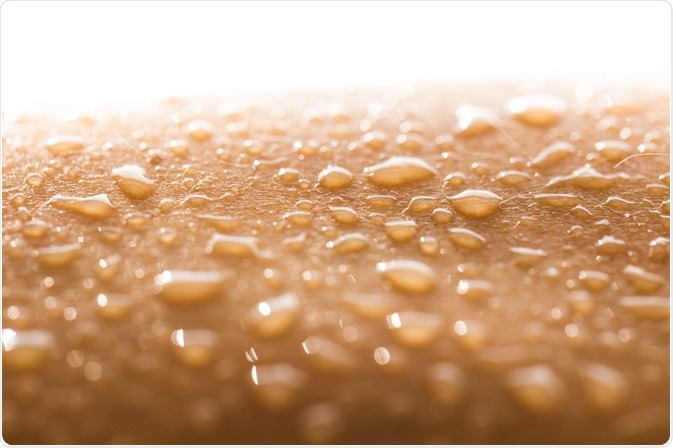While many analytical methods exist for detecting evidence of cannabis use in biological samples, these blood and urine tests have many limitations.

Image Credit: Billion Photos/Shutterstock.com
Sweat offers an opportunity to establish an alternative method of cannabis detection that researchers believe can overcome these limitations.
In 2016, a team of scientists from the University of Perugia and Sacred Heart Catholic University in Italy established a new method for testing cannabis use by sweat analysis.
In a paper, published in the journal Therapeutic Drug Monitoring, the team describes how this non-invasive and reliable method could be used to help monitor compliance with rehabilitation therapies.
Why do we need to test for cannabis use?
Cannabis is generally considered fairly low risk in terms of its addictiveness in comparison with other drugs, alcohol, and tobacco. However, recent data estimates that over half of all Americans have tried the drug at least once and other studies have found that around a third of those who use cannabis have a substance use disorder to some extent.
Although it is not considered to be highly addictive in terms of how likely it is a person will develop an addiction following the single use of the drug, frequent cannabis use can lead to a dependence on the substance. Recent figures estimate around 5–10% of cannabis users go on to develop a dependence.
Increased mortality and cannabis dependence are not strongly linked, as it is for other drug dependencies such as heroin users who have a 3-4-fold greater chance of premature death. However, recent research has uncovered its association with motor vehicle accidents and lung cancer.
Also, a systematic review recently found that cannabis users were slightly more likely to develop psychosis than non-users. Other factors have also been linked with cannabis use, such as cognitive and motivational problems, memory deficits, relationship problems, and financial difficulties.
Given these detrimental effects of the drug, along with the fact that it is the most commonly cultivated and trafficked illicit drug, accurate and reliable drug testing methods are required to help monitor adherence to rehabilitation treatments.
Issues related to current drug detection methods
Currently, there are several methods for testing whether a person has been using cannabis. Routine drug sampling usually relies on collecting samples of either blood or urine for analysis, but hair and oral fluid can also be used. However, there are several issues related to these processes.
Blood samples generally can only detect drug use that has occurred close to the time of testing, also, it is an invasive procedure that requires trained staff.
Urine samples can detect substance use in a larger time window, however, there is a long turnaround time to get results back, sometimes of two days or more, which can be crucial for a forensic investigation.
Also, samples taken from oral fluids can easily be contaminated by residual traces left in the mouth (e.g food residue, hygiene products). Finally, hair samples cannot determine recent drug use and some people do not grow hair long enough in length to be tested.
A new method of cannabis use analysis using sweat
To overcome these limitations, the Italian research team explored a way of using gas chromatography-mass spectrometry to test for the presence of cannabis in sweat patch samples. To study the method’s efficacy the team collected urine, hair, and sweat samples from 12 people who were being monitored for cannabis abuse.
The limit of detection was measured for all sample types, revealing that sweat was at a level comparable to urine and hair methods.
Results showed that the chromatography-mass spectrometry method was capable of detecting D9-tetrahydrocannabinol (the principal psychoactive compound found in cannabis) in all sweat samples. Urine and hair tests also detected this substance in 100% of the samples.
However, sweat analysis was not able to detect the presence of 11-nor-D9- tetrahydrocannabinol-9-carboxylic acid, the main secondary metabolite of tetrahydrocannabinol, which is developed in the body following cannabis use.
Nevertheless, because of its accuracy in detecting D9-tetrahydrocannabinol, sweat analysis is considered to be a viable, non-invasive method for the monitoring of cannabis use to help measure compliance with rehabilitation therapies.
This method may become more commonplace in the future, once it has been tested on a much larger donor pool, as it overcomes the limitations of testing other biological samples, such as blood, urine, and hair.
Sources:
- Fischer, B., Imtiaz, S., Rudzinski, K. and Rehm, J. (2015). Crude estimates of cannabis-attributable mortality and morbidity in Canada–implications for public health focused intervention priorities. Journal of Public Health, 38(1), pp.183-188. https://academic.oup.com/jpubhealth/article/38/1/183/2362575
- Gambelunghe, C., Fucci, N., Aroni, K., Bacci, M., Marcelli, A. and Rossi, R. (2016). Cannabis Use Surveillance by Sweat Analysis. Therapeutic Drug Monitoring, 38(5), pp.634-639. https://www.ncbi.nlm.nih.gov/pubmed/27465974
- Hasin, D., Saha, T., Kerridge, B., Goldstein, R., Chou, S., Zhang, H., Jung, J., Pickering, R., Ruan, W., Smith, S., Huang, B. and Grant, B. (2015). Prevalence of Marijuana Use Disorders in the United States Between 2001-2002 and 2012-2013. JAMA Psychiatry, 72(12), p.1235. https://www.ncbi.nlm.nih.gov/pubmed/26502112
Further Reading
Last Updated: Mar 18, 2020